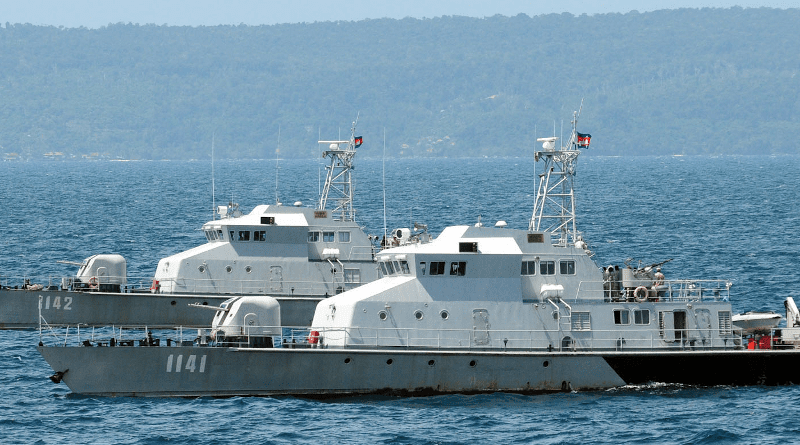Cambodia Naval Base Gets A Chinese Upgrade – Analysis
By Michael Hart
Satellite images released in early-October revealed recent construction at Ream Naval Base on Cambodia’s Gulf of Thailand coast, part of a China-backed redevelopment plan. The Asia Maritime Transparency Initiative reported that over August and September, three new buildings had been constructed, while several areas had been cleared of foliage and a road was under development. The activity comes amid concern by the United States that Chinese activity at the base, where an US-built facility was razed in 2019, could be intended to enable a future Chinese military presence.
The Cambodian authorities maintain that the construction work, involving a newly-dredged port and ship-repair facility, is part of an expansion project in Cambodia’s national interest, while insisting that the Southeast Asian nation does not intend to play host to Chinese troops. Yet whatever the truth, or the strategic implications of a potential Chinese staging post on the Gulf of Thailand, the growing disquiet in Washington over the Beijing-backed upgrade of the base reflects a realization that there is very little the United States can do to avoid yielding influence to China in Cambodia.
Naval base upgrades
The first indication of changes at Ream came in 2019, when The Wall Street Journal published an article claiming that China’s People’s Liberation Army Navy had signed a secret deal with Cambodia granting it future access to the base. Cambodia refuted the report, but in October 2020 it emerged that a building constructed by the United States at Ream—the tactical headquarters of the National Committee on Maritime Security—had been demolished, along with a maintenance facility and boat ramp. Cambodia’s Ministry of Defense later said the headquarters would be rebuilt further along the coast at Koh Preab, near the port of Sihanoukville, to make way for the expansion of the naval base.
On a visit to Phnom Penh this June, United States Deputy Secretary of State Wendy Sherman voiced “serious concerns” over China’s alleged “military presence” at Ream during a meeting with Hun Sen, Cambodia’s longtime prime minister, and sought clarification over the “demolition of two US-funded buildings at Ream without notice or explanation.” Cambodia agreed that a defense attaché from the American embassy, Colonel Marcus Ferrara, could visit the base on 11 June, but he cut the trip short having been denied full access. Afterwards, Cambodia’s defense ministry told Radio Free Asia that it had a right to protect its “military secrecy” and that the areas to be visited were agreed in advance.
US-Cambodia tensions
Tensions between Cambodia and the United States over the base come after years of deteriorating relations, sparked by the dissolution of the opposition Cambodia National Rescue Party in 2017 after it had come close to defeating Hun Sen’s long-ruling Cambodian People’s Party in elections. Shunned by most Western states and sanctioned by the European Union amid a political crackdown which has seen hundreds of opposition activists detained, Cambodia has consciously drifted into China’s orbit.
The United States has expressed concern over the consequences. In a March 2021 Senate hearing, chief of the military’s Indo-Pacific Command, Admiral Philip Davidson, told lawmakers that “the US and other countries in the region are concerned about the expansion of PRC influence in Cambodia and its implication for regional security.” Sherman warned in June that a future Chinese military base in Cambodia would “undermine its sovereignty… and negatively impact US-Cambodia relations,” and urged its leadership to “maintain an independent and balanced foreign policy.” A spokesperson from the US embassy in Phnom Penh last month called for Cambodia to be transparent about the “intent, nature and scope” of redevelopment work at Ream, particularly over “the role of the PRC military.”
While Cambodian officials have acknowledged Chinese financing of the project, the exact funding arrangements and timescale for construction are unclear. Minister of Defense, Tea Banh, classified the funding as development assistance in comments to the Phnom Penh Post in June, and repeated that “this help comes without strings attached.” Prime Minister Hun Sen has previously stated that hosting foreign forces is unconstitutional but that the base will “welcome ships from any country.”
Strategic implications
Under Hun Sen’s leadership, however, Cambodia has in recent years drifted away from the United States and allied closely with China. In 2017, it suspended joint military drills with American troops. Cambodia has held several annual “Golden Dragon” joint exercises with China, yet stationing naval assets at Ream would only bring relatively small strategic benefits to China, as Chen Heang recently argued in The Diplomat. Waters off the coast are too shallow for submarine access, while a Chinese presence there would not allow it to circumnavigate the shipping chokepoint of the Malacca Strait.
However, even without a permanent force, regular use of Ream by Chinese vessels would signal a win for Beijing in its tug-of-war with the United States over the region, particularly in the contested maritime space. Along China’s southern frontier, smaller states are ditching Western aid for Chinese finance for infrastructure, and some—like Cambodia—may grant China preferential access in return. The United States should not be all that surprised. After all, due to its own power, it has maintained bases in the past and still benefits from access rights regionwide—most notably in Thailand and the Philippines. Now China is seeking the same advantages, leaving the US with company in Asia’s seas.
This article was published by Geopolitical Monitor.com

